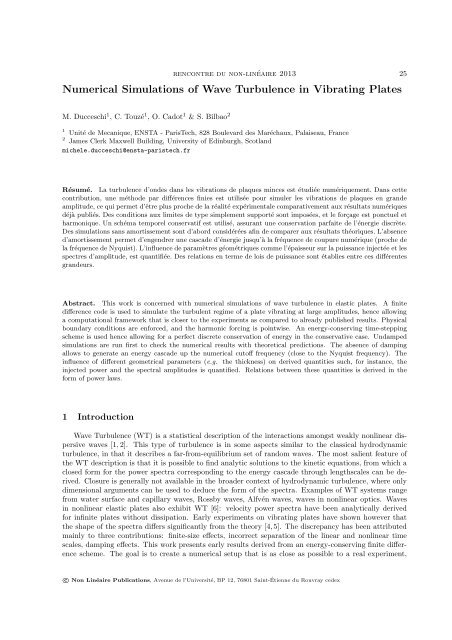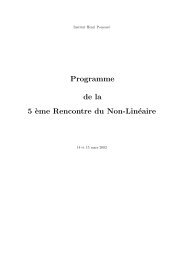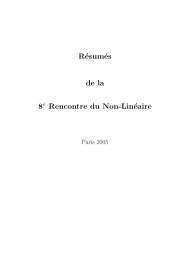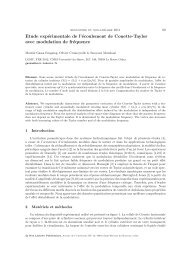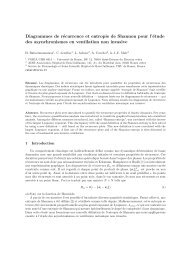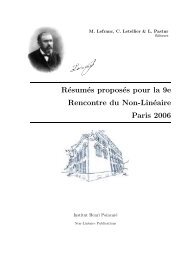Rencontre du Non-Linéaire
l'intégralité des comptes-rendus - science non linéaire
l'intégralité des comptes-rendus - science non linéaire
- No tags were found...
Create successful ePaper yourself
Turn your PDF publications into a flip-book with our unique Google optimized e-Paper software.
encontre <strong>du</strong> non-linéaire 2013 25<br />
Numerical Simulations of Wave Turbulence in Vibrating Plates<br />
M. Ducceschi 1 , C. Touzé 1 , O. Cadot 1 & S. Bilbao 2<br />
1 Unité de Mecanique, ENSTA - ParisTech, 828 Boulevard des Maréchaux, Palaiseau, France<br />
2 James Clerk Maxwell Building, University of Edinburgh, Scotland<br />
michele.<strong>du</strong>cceschi@ensta-paristech.fr<br />
Résumé. La turbulence d’ondes dans les vibrations de plaques minces est étudiée numériquement. Dans cette<br />
contribution, une méthode par différences finies est utilisée pour simuler les vibrations de plaques en grande<br />
amplitude, ce qui permet d’être plus proche de la réalité expérimentale comparativement aux résultats numériques<br />
déjà publiés. Des conditions aux limites de type simplement supporté sont imposées, et le forçage est ponctuel et<br />
harmonique. Un schéma temporel conservatif est utilisé, assurant une conservation parfaite de l’énergie discrète.<br />
Des simulations sans amortissement sont d’abord considérées afin de comparer aux résultats théoriques. L’absence<br />
d’amortissement permet d’engendrer une cascade d’énergie jusqu’à la fréquence de coupure numérique (proche de<br />
la fréquence de Nyquist). L’influence de paramètres géométriques comme l’épaisseur sur la puissance injectée et les<br />
spectres d’amplitude, est quantifiée. Des relations en terme de lois de puissance sont établies entre ces différentes<br />
grandeurs.<br />
Abstract. This work is concerned with numerical simulations of wave turbulence in elastic plates. A finite<br />
difference code is used to simulate the turbulent regime of a plate vibrating at large amplitudes, hence allowing<br />
a computational framework that is closer to the experiments as compared to already published results. Physical<br />
boundary conditions are enforced, and the harmonic forcing is pointwise. An energy-conserving time-stepping<br />
scheme is used hence allowing for a perfect discrete conservation of energy in the conservative case. Undamped<br />
simulations are run first to check the numerical results with theoretical predictions. The absence of damping<br />
allows to generate an energy cascade up the numerical cutoff frequency (close to the Nyquist frequency). The<br />
influence of different geometrical parameters (e.g. the thickness) on derived quantities such, for instance, the<br />
injected power and the spectral amplitudes is quantified. Relations between these quantities is derived in the<br />
form of power laws.<br />
1 Intro<strong>du</strong>ction<br />
Wave Turbulence (WT) is a statistical description of the interactions amongst weakly nonlinear dispersive<br />
waves [1,2]. This type of turbulence is in some aspects similar to the classical hydrodynamic<br />
turbulence, in that it describes a far-from-equilibrium set of random waves. The most salient feature of<br />
the WT description is that it is possible to find analytic solutions to the kinetic equations, from which a<br />
closed form for the power spectra corresponding to the energy cascade through lengthscales can be derived.<br />
Closure is generally not available in the broader context of hydrodynamic turbulence, where only<br />
dimensional arguments can be used to de<strong>du</strong>ce the form of the spectra. Examples of WT systems range<br />
from water surface and capillary waves, Rossby waves, Alfvén waves, waves in nonlinear optics. Waves<br />
in nonlinear elastic plates also exhibit WT [6]: velocity power spectra have been analytically derived<br />
for infinite plates without dissipation. Early experiments on vibrating plates have shown however that<br />
the shape of the spectra differs significantly from the theory [4,5]. The discrepancy has been attributed<br />
mainly to three contributions: finite-size effects, incorrect separation of the linear and nonlinear time<br />
scales, damping effects. This work presents early results derived from an energy-conserving finite difference<br />
scheme. The goal is to create a numerical setup that is as close as possible to a real experiment,<br />
c○ <strong>Non</strong> <strong>Linéaire</strong> Publications, Avenue de l’Université, BP 12, 76801 Saint-Étienne <strong>du</strong> Rouvray cedex


